Artwork in Early Renaissance, Northern European Renaissance and Italian Renaissance
VerifiedAdded on 2023/04/23
|6
|743
|452
AI Summary
This document explores the artwork in Early Renaissance, Northern European Renaissance and Italian Renaissance. It discusses the historical facts behind the monuments illustrated above. The document also highlights the changes in the field of arts over the years.
Contribute Materials
Your contribution can guide someone’s learning journey. Share your
documents today.
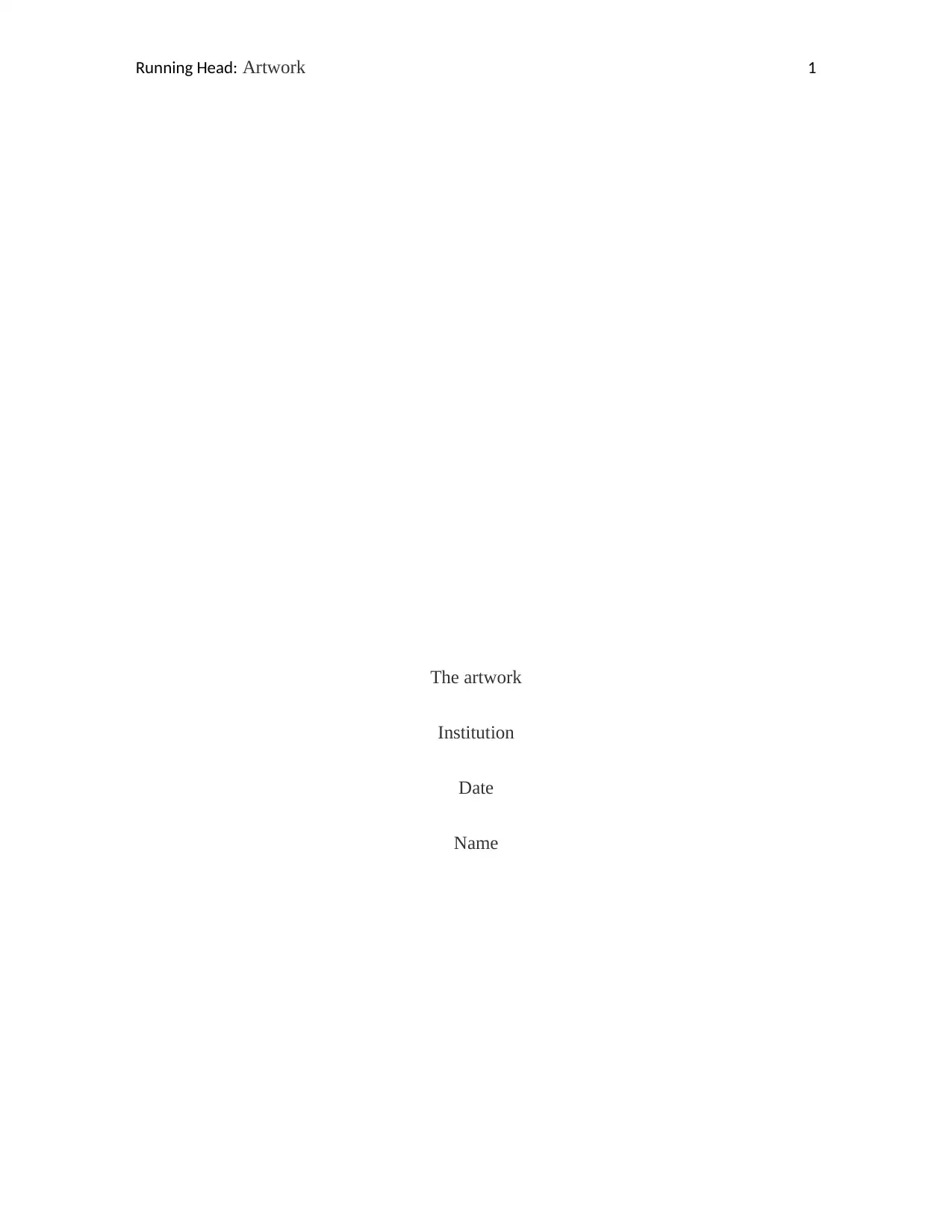
Running Head: Artwork 1
The artwork
Institution
Date
Name
The artwork
Institution
Date
Name
Secure Best Marks with AI Grader
Need help grading? Try our AI Grader for instant feedback on your assignments.
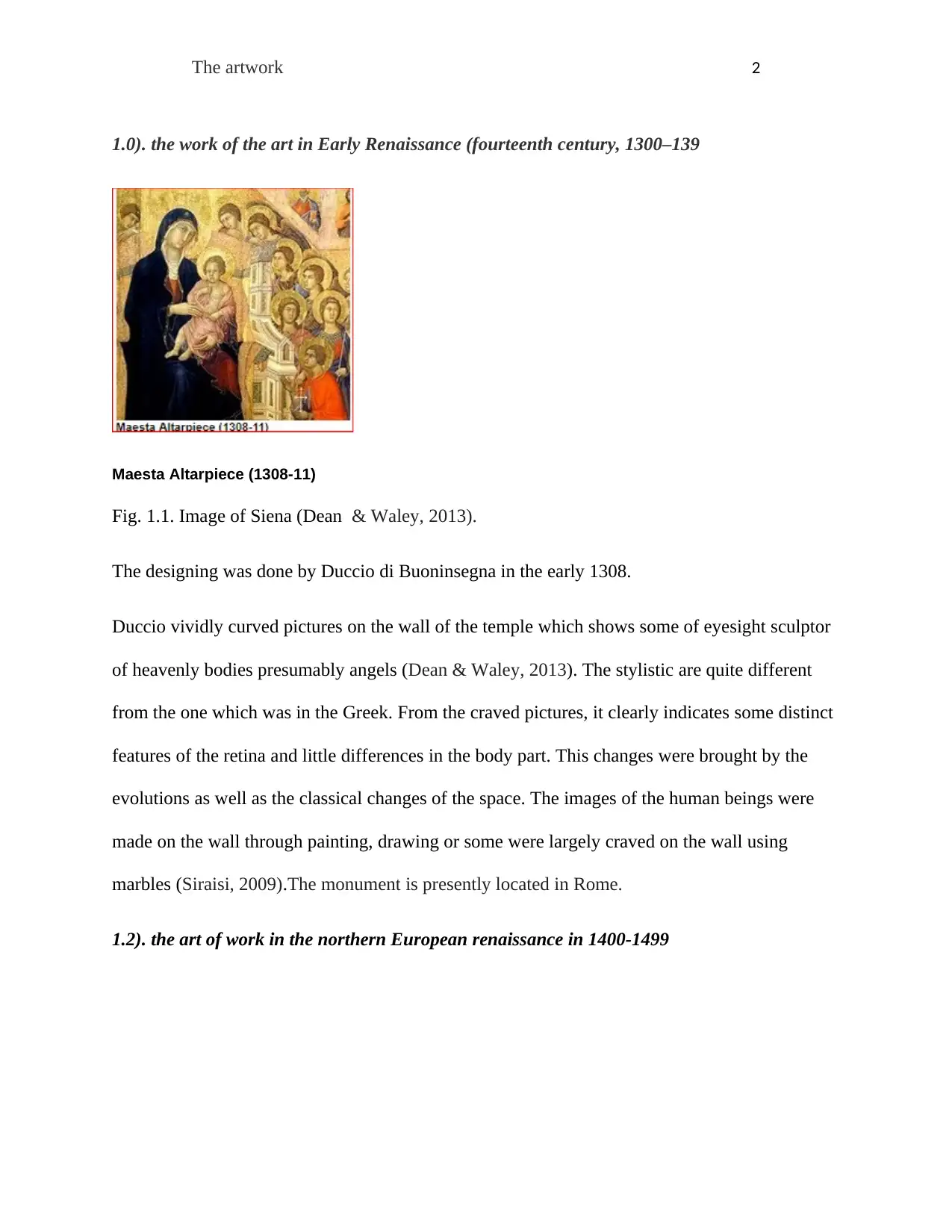
The artwork 2
1.0). the work of the art in Early Renaissance (fourteenth century, 1300–139
Maesta Altarpiece (1308-11)
Fig. 1.1. Image of Siena (Dean & Waley, 2013).
The designing was done by Duccio di Buoninsegna in the early 1308.
Duccio vividly curved pictures on the wall of the temple which shows some of eyesight sculptor
of heavenly bodies presumably angels (Dean & Waley, 2013). The stylistic are quite different
from the one which was in the Greek. From the craved pictures, it clearly indicates some distinct
features of the retina and little differences in the body part. This changes were brought by the
evolutions as well as the classical changes of the space. The images of the human beings were
made on the wall through painting, drawing or some were largely craved on the wall using
marbles (Siraisi, 2009).The monument is presently located in Rome.
1.2). the art of work in the northern European renaissance in 1400-1499
1.0). the work of the art in Early Renaissance (fourteenth century, 1300–139
Maesta Altarpiece (1308-11)
Fig. 1.1. Image of Siena (Dean & Waley, 2013).
The designing was done by Duccio di Buoninsegna in the early 1308.
Duccio vividly curved pictures on the wall of the temple which shows some of eyesight sculptor
of heavenly bodies presumably angels (Dean & Waley, 2013). The stylistic are quite different
from the one which was in the Greek. From the craved pictures, it clearly indicates some distinct
features of the retina and little differences in the body part. This changes were brought by the
evolutions as well as the classical changes of the space. The images of the human beings were
made on the wall through painting, drawing or some were largely craved on the wall using
marbles (Siraisi, 2009).The monument is presently located in Rome.
1.2). the art of work in the northern European renaissance in 1400-1499
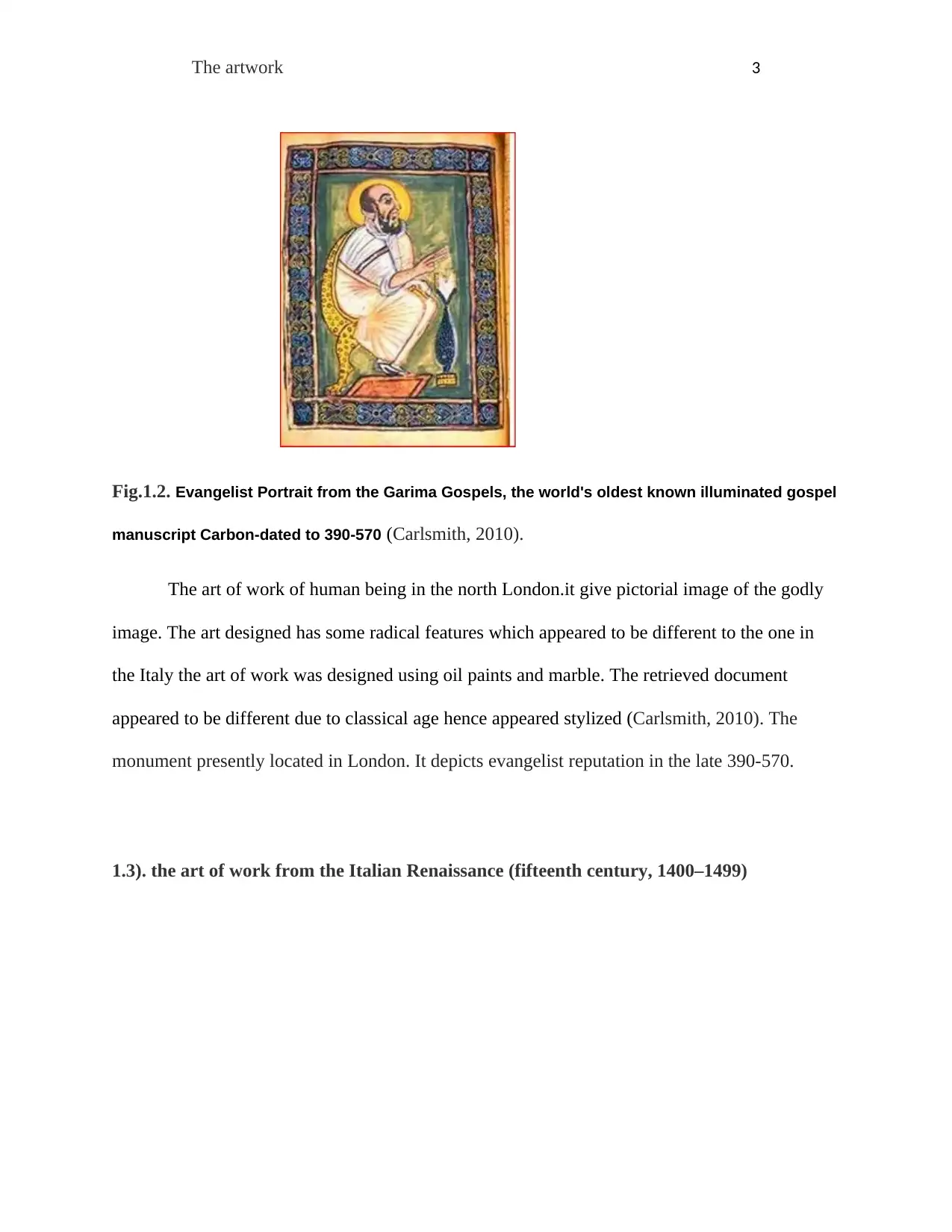
The artwork 3
Fig.1.2. Evangelist Portrait from the Garima Gospels, the world's oldest known illuminated gospel
manuscript Carbon-dated to 390-570 (Carlsmith, 2010).
The art of work of human being in the north London.it give pictorial image of the godly
image. The art designed has some radical features which appeared to be different to the one in
the Italy the art of work was designed using oil paints and marble. The retrieved document
appeared to be different due to classical age hence appeared stylized (Carlsmith, 2010). The
monument presently located in London. It depicts evangelist reputation in the late 390-570.
1.3). the art of work from the Italian Renaissance (fifteenth century, 1400–1499)
Fig.1.2. Evangelist Portrait from the Garima Gospels, the world's oldest known illuminated gospel
manuscript Carbon-dated to 390-570 (Carlsmith, 2010).
The art of work of human being in the north London.it give pictorial image of the godly
image. The art designed has some radical features which appeared to be different to the one in
the Italy the art of work was designed using oil paints and marble. The retrieved document
appeared to be different due to classical age hence appeared stylized (Carlsmith, 2010). The
monument presently located in London. It depicts evangelist reputation in the late 390-570.
1.3). the art of work from the Italian Renaissance (fifteenth century, 1400–1499)
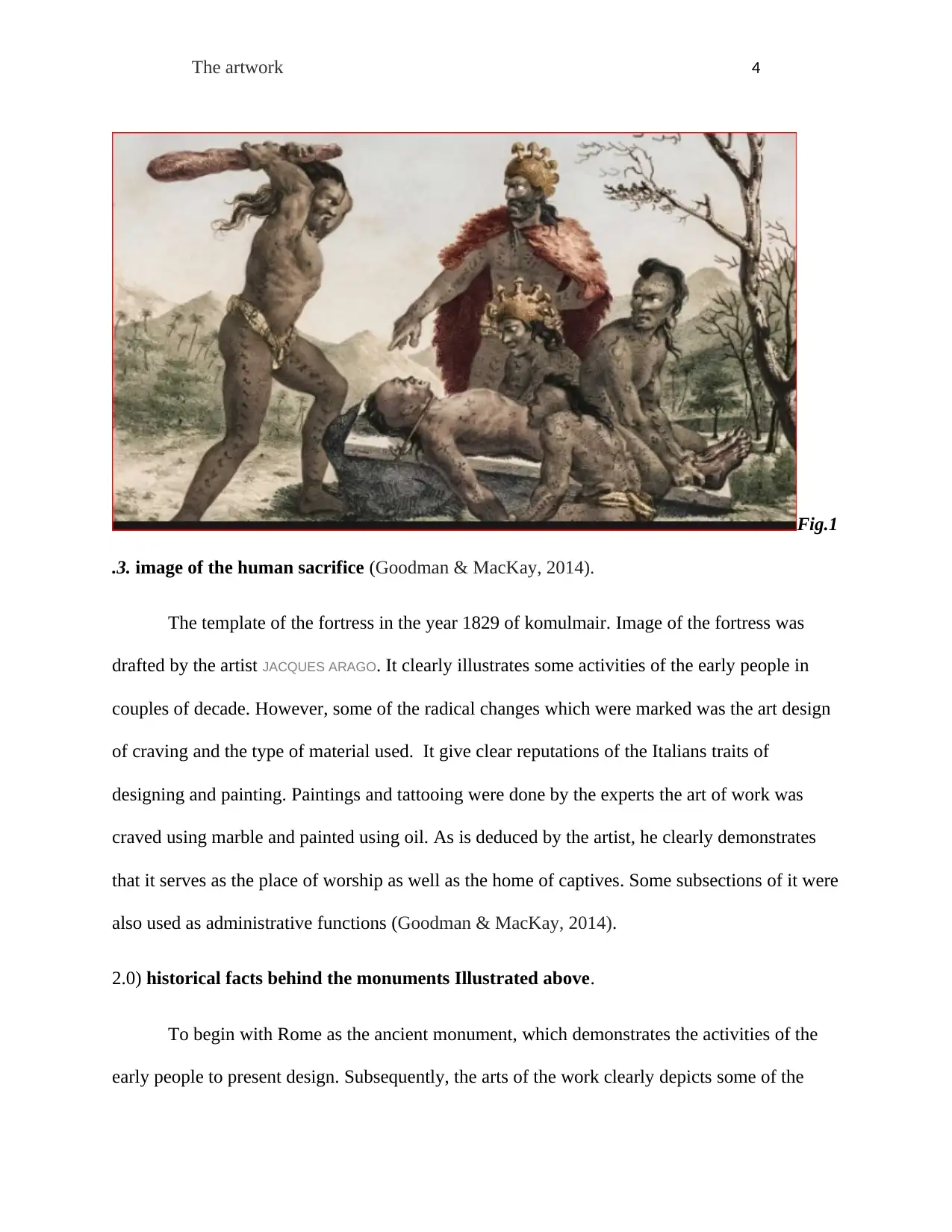
The artwork 4
Fig.1
.3. image of the human sacrifice (Goodman & MacKay, 2014).
The template of the fortress in the year 1829 of komulmair. Image of the fortress was
drafted by the artist JACQUES ARAGO. It clearly illustrates some activities of the early people in
couples of decade. However, some of the radical changes which were marked was the art design
of craving and the type of material used. It give clear reputations of the Italians traits of
designing and painting. Paintings and tattooing were done by the experts the art of work was
craved using marble and painted using oil. As is deduced by the artist, he clearly demonstrates
that it serves as the place of worship as well as the home of captives. Some subsections of it were
also used as administrative functions (Goodman & MacKay, 2014).
2.0) historical facts behind the monuments Illustrated above.
To begin with Rome as the ancient monument, which demonstrates the activities of the
early people to present design. Subsequently, the arts of the work clearly depicts some of the
Fig.1
.3. image of the human sacrifice (Goodman & MacKay, 2014).
The template of the fortress in the year 1829 of komulmair. Image of the fortress was
drafted by the artist JACQUES ARAGO. It clearly illustrates some activities of the early people in
couples of decade. However, some of the radical changes which were marked was the art design
of craving and the type of material used. It give clear reputations of the Italians traits of
designing and painting. Paintings and tattooing were done by the experts the art of work was
craved using marble and painted using oil. As is deduced by the artist, he clearly demonstrates
that it serves as the place of worship as well as the home of captives. Some subsections of it were
also used as administrative functions (Goodman & MacKay, 2014).
2.0) historical facts behind the monuments Illustrated above.
To begin with Rome as the ancient monument, which demonstrates the activities of the
early people to present design. Subsequently, the arts of the work clearly depicts some of the
Secure Best Marks with AI Grader
Need help grading? Try our AI Grader for instant feedback on your assignments.
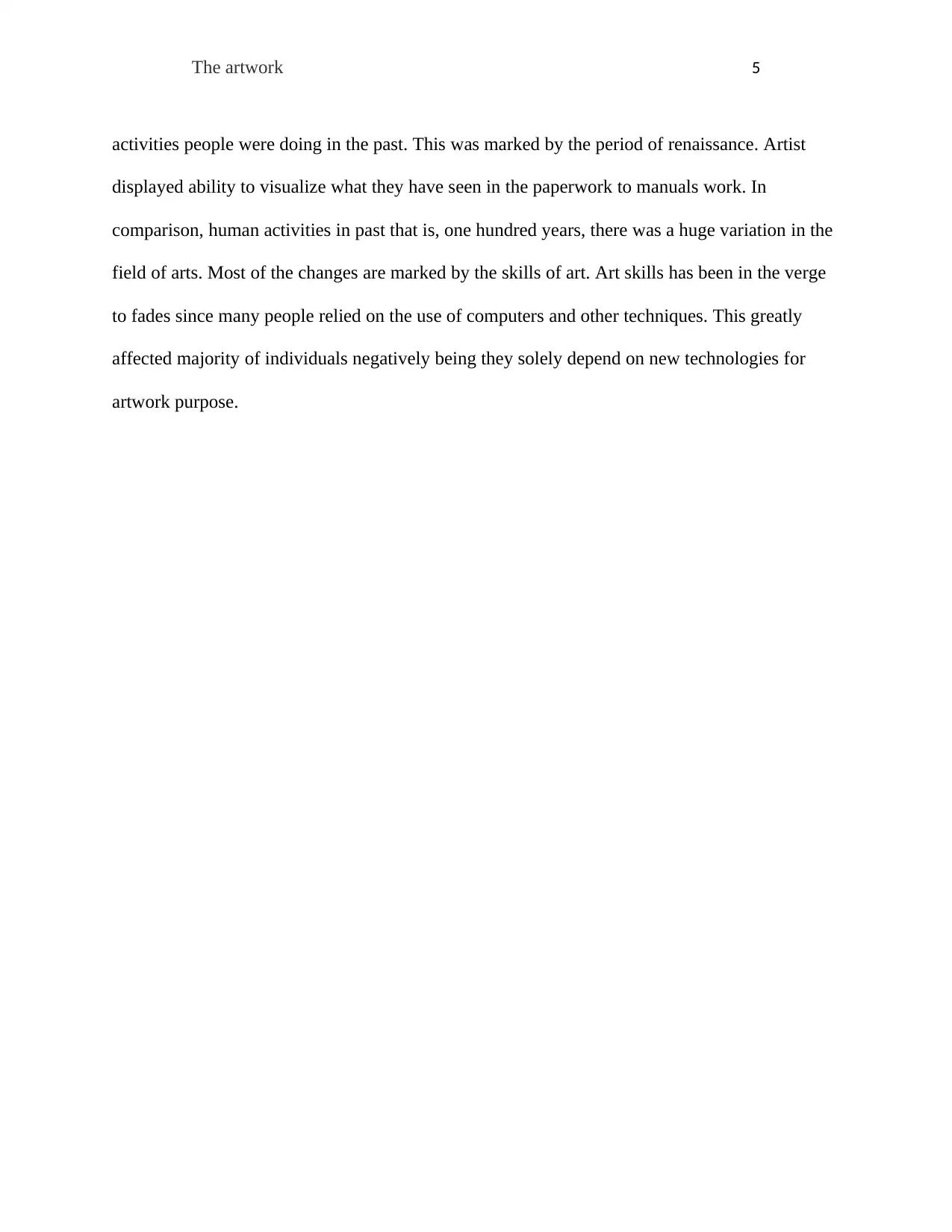
The artwork 5
activities people were doing in the past. This was marked by the period of renaissance. Artist
displayed ability to visualize what they have seen in the paperwork to manuals work. In
comparison, human activities in past that is, one hundred years, there was a huge variation in the
field of arts. Most of the changes are marked by the skills of art. Art skills has been in the verge
to fades since many people relied on the use of computers and other techniques. This greatly
affected majority of individuals negatively being they solely depend on new technologies for
artwork purpose.
activities people were doing in the past. This was marked by the period of renaissance. Artist
displayed ability to visualize what they have seen in the paperwork to manuals work. In
comparison, human activities in past that is, one hundred years, there was a huge variation in the
field of arts. Most of the changes are marked by the skills of art. Art skills has been in the verge
to fades since many people relied on the use of computers and other techniques. This greatly
affected majority of individuals negatively being they solely depend on new technologies for
artwork purpose.
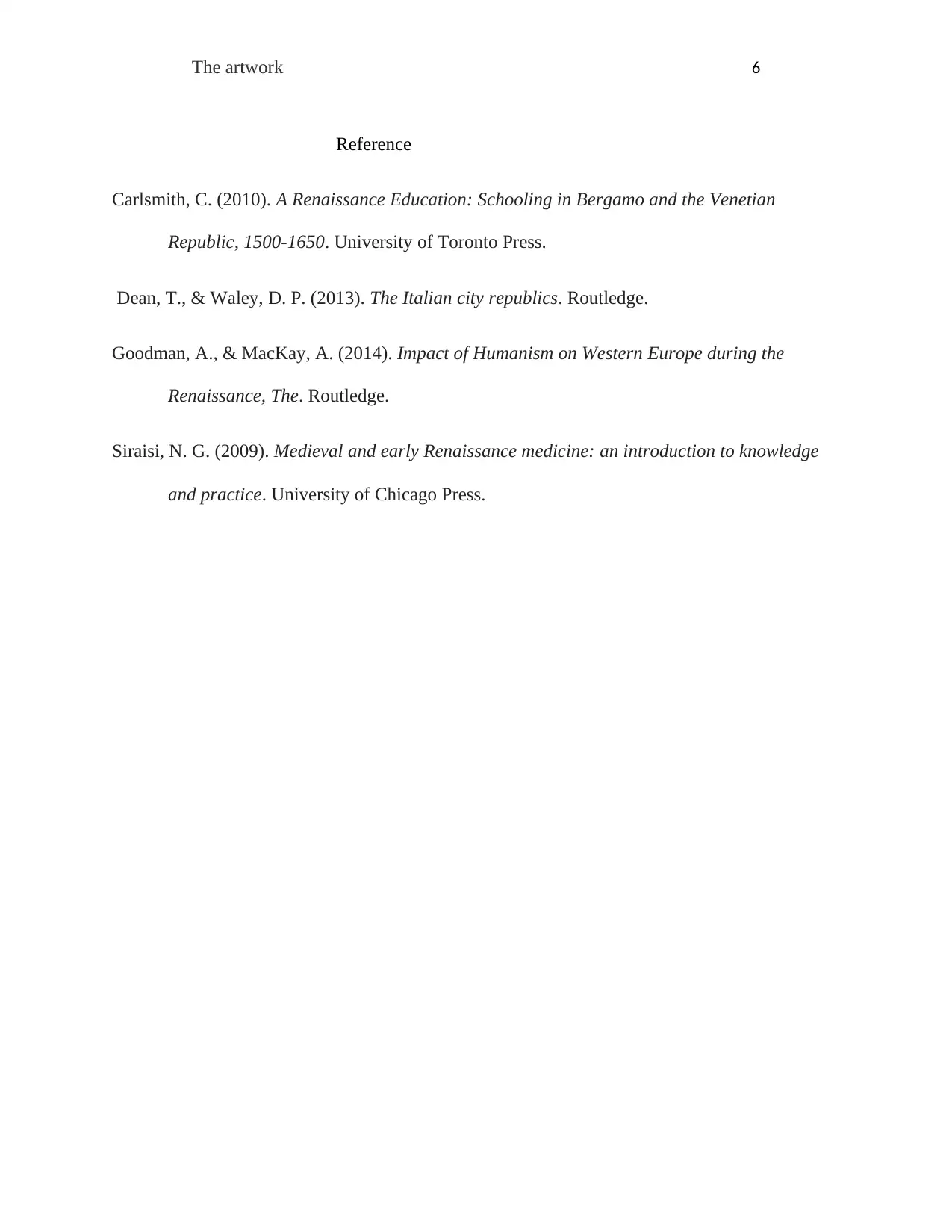
The artwork 6
Reference
Carlsmith, C. (2010). A Renaissance Education: Schooling in Bergamo and the Venetian
Republic, 1500-1650. University of Toronto Press.
Dean, T., & Waley, D. P. (2013). The Italian city republics. Routledge.
Goodman, A., & MacKay, A. (2014). Impact of Humanism on Western Europe during the
Renaissance, The. Routledge.
Siraisi, N. G. (2009). Medieval and early Renaissance medicine: an introduction to knowledge
and practice. University of Chicago Press.
Reference
Carlsmith, C. (2010). A Renaissance Education: Schooling in Bergamo and the Venetian
Republic, 1500-1650. University of Toronto Press.
Dean, T., & Waley, D. P. (2013). The Italian city republics. Routledge.
Goodman, A., & MacKay, A. (2014). Impact of Humanism on Western Europe during the
Renaissance, The. Routledge.
Siraisi, N. G. (2009). Medieval and early Renaissance medicine: an introduction to knowledge
and practice. University of Chicago Press.
1 out of 6
Your All-in-One AI-Powered Toolkit for Academic Success.
+13062052269
info@desklib.com
Available 24*7 on WhatsApp / Email
![[object Object]](/_next/static/media/star-bottom.7253800d.svg)
Unlock your academic potential
© 2024 | Zucol Services PVT LTD | All rights reserved.